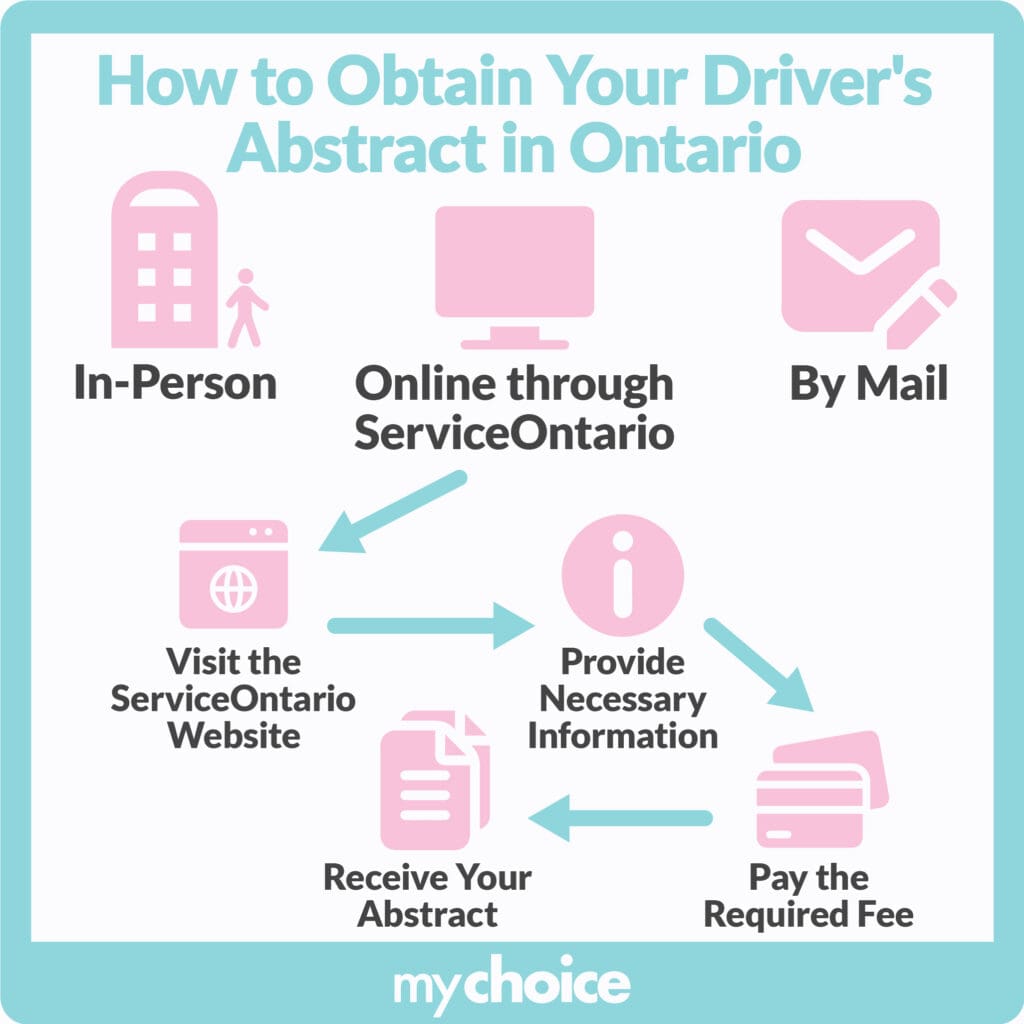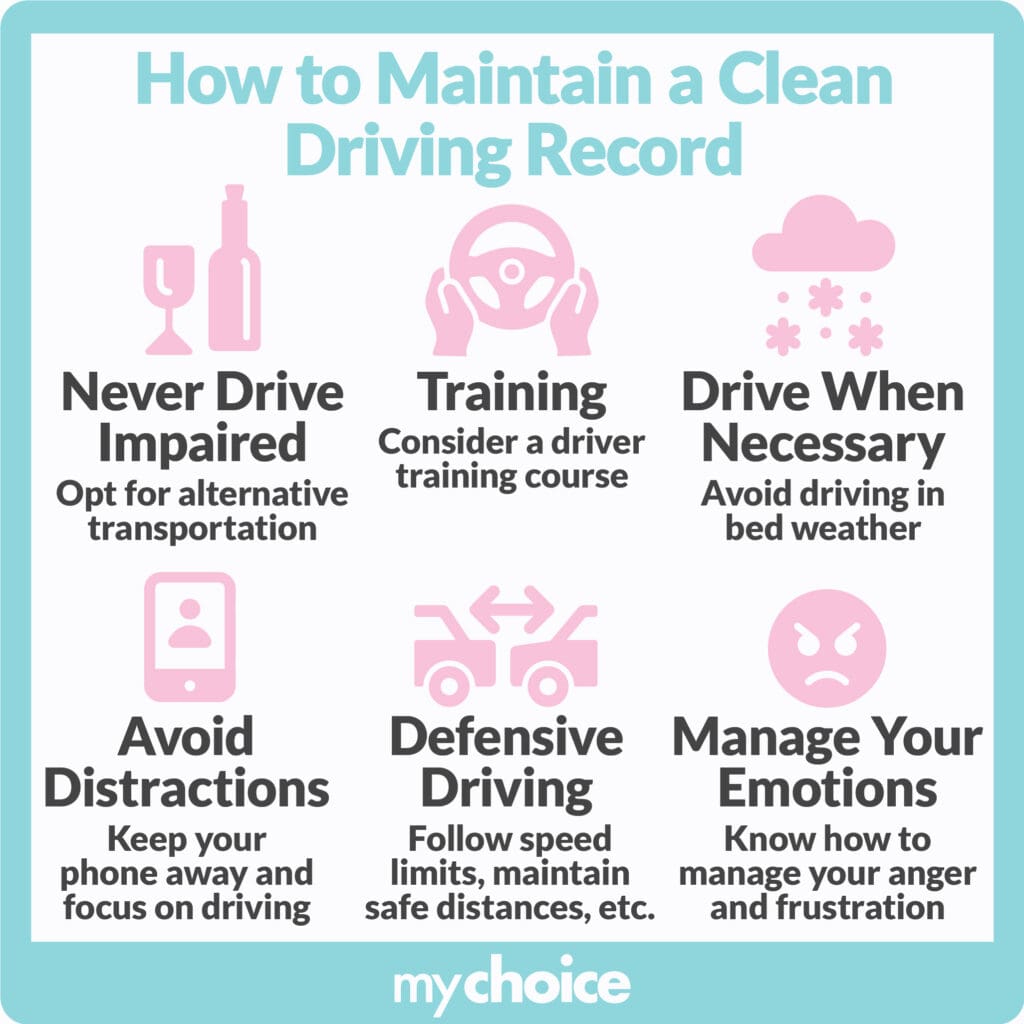You can get an Ontario driver’s abstract by ordering one at the Ministry of Transportation. You can either order one online or go to your nearest ServiceOntario office.
Getting a Driver’s Abstract or Record at a Glance
- A driver’s abstract is issued by the Ministry of Transportation.
- You can get an uncertified copy immediately, while certified copies take 15 business days to process.
- Your driver’s abstract generally includes your personal information, driver’s licence status, and record of driving violations.
- A driver’s abstract is usually used to apply for jobs, insurance policies, or other background-checking purposes.
- You can get a driver’s abstract online, in person at a ServiceOntario location, or by mail.
- Most driving infractions stay on your record for three years, while at-fault accidents may stay there for ten years.
Want to learn more about Ontario’s driver’s abstract and its use? Let’s dive deeper.
The Cost of Driver’s Abstracts
The Ontario government issues two types of similarly-priced driver’s abstracts: the 3-year driver record and the driver’s licence history. An uncertified copy of either abstract costs $12, and it’s the most common type of abstract you need. Meanwhile, a certified copy costs $18.
How Long Does a Driver’s Abstract Take to Get?
You can get an uncertified driver’s abstract immediately if you order online or request one at a ServiceOntario location. If you order one by mail, you can get it within 15 business days. Meanwhile, certified copies take 15 business days to issue regardless of where you ordered them.
Contents of an Ontario Driver’s Abstract
There are two types of driver’s abstracts issued by ServiceOntario. Both types of driver’s abstracts include the following driver identification details:
- Your name
- Your licence number
- Date of birth
- Sex
- Height
- Your licence class
- Expiry date
- Your driver’s licence status
- The earliest licence date available
- Condition notes, like a glasses requirement or ability to drive vehicles with air brakes
In addition to the driver identification details, each driver’s abstract type has unique information listed on them. Let’s take a look at the two document types and what they include.
3-Year Driver Record
Your 3-year driver record document will contain the following information:
- Your demerit point total
- Your active Highway Traffic Act and Criminal Code convictions, suspensions, and reinstatements over the past three years
Licence History
Your driver’s licence history includes:
- Your Ontario beginner driver education course completion
- A record of all license renewals, replacements, and class changes.
- A record of your residential addresses if you order the abstract online or by mail.
What Are Driver’s Abstracts For?
Generally, driver’s abstracts are used for the following reasons:
- Applying for a job.
- Applying for a driver’s licence outside Ontario.
- Getting auto insurance in Ontario.
- Confirming your address in court.
In addition to the aforementioned uses, your driver’s abstract can be used for other background-checking purposes.
Certified vs Uncertified Abstracts
For most purposes we’ve covered above, you’ll likely only need an uncertified abstract. The certified version comes with a seal from the Ministry of Transportation and it’s mostly used for legal purposes.
Who Can See Your Driving Record?
Everybody who requests your three-year driving record and pays the fee can see it. However, your address will remain confidential. People who are the most likely to request your driving record are insurance companies, the police, and judicial services.
Ordering Your Driver’s Abstract
You can order your driver’s abstract through the Internet, in person at ServiceOntario, or by mail. Let’s take a look at how to order an abstract with each method:
Online
- Visit the relevant order page. For instance, this is the online form for an uncertified 3-year driver record.
- Input your driver’s licence number.
- Pay with Visa or Mastercard.
- Save or print the document immediately.
Note that you can’t order driver’s abstracts in bulk through this page. If you need to bulk order a lot of abstracts, you can contact the Ministry of Transportation’s representative at ARIS@ontario.ca.
In Person at ServiceOntario
- Go to your nearest ServiceOntario location.
- Explain which type of abstract you’d like to order.
- Pay with Visa or Mastercard credit cards, cash, debit cards, or cheques.
- Download the application form.
- Fill and complete the form.
- Send the form via mail to the Ministry of Transportation.
- Pay with Visa or Mastercard credit cards or cheques.

How to Make Your Driver’s Abstract Look Good
Your driver’s abstract can be the deciding factor for whether you land a job, get low insurance rates, and other critical decisions. To ensure you have the best odds of getting a good result, you need to make your driver’s abstract look good.
To do so, you need to have a clean driving record. Here are several ways that you can get a clean driving record and keep your driver’s abstract looking squeaky clean:
- Stay within speed limits.
- Maintain safe distance from surrounding vehicles.
- Follow the rules of the road.
- Participate in a driver’s training course.
- Limit your driving time if possible.
- Avoid driving while distracted. Ontario’s distracted driving laws especially prohibit the use of handheld electronic devices.
- Never drive while impaired. If you’re impaired and still need to drive home, consider using alternative transportation like cabs.
- Avoid driving in bad weather like storms and heavy rain.
- Stay calm on the road to avoid conflicts with other drivers.
- Review your past driver’s abstracts to learn your past mistakes, so you can improve on them.
Remember, driving infractions generally stay on your record for three years, and at-fault accidents may last for ten. Since your mistakes can haunt you for a long time, it’s best not to make those mistakes in the first place. Check our guide on how long car accidents stay on your driving record to learn more.
If it’s too late and you already have infractions on your driving record, you probably shouldn’t add any more. Improve your driving and make sure you follow the tips above.

Key Advice From MyChoice
Now that we’ve learned about driver’s abstracts and driving records, here are some pieces of advice you can follow:
- For most purposes like employment applications and insurance purchases, you only need an uncertified driver’s abstract.
- Uncertified abstracts are issued immediately, while certified copies take 15 business days to deliver.
- Having a clean driving record is the best way to make your driver’s abstract look good. Take all the measures you can to avoid accidents and traffic infractions that can damage your record.
You can visit MyChoice to learn more about auto insurance in Canada. We also have a wealth of guides on other insurance-related topics.








